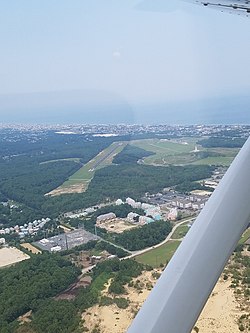First Flight Airport | |||||||||||
|---|---|---|---|---|---|---|---|---|---|---|---|
 First Flight Airport from 1000 feet | |||||||||||
| Summary | |||||||||||
| Airport type | Public | ||||||||||
| Owner | U.S. National Park Service | ||||||||||
| Serves | Kill Devil Hills, North Carolina | ||||||||||
| Location | Wright Brothers National Memorial | ||||||||||
| Elevation AMSL | 13 ft / 4 m | ||||||||||
| Coordinates | 36°01′06″N 075°40′17″W / 36.01833°N 75.67139°W | ||||||||||
| Website |
www | ||||||||||
| Map | |||||||||||
|
| |||||||||||
| Runways | |||||||||||
| |||||||||||
| Statistics (2018) | |||||||||||
| |||||||||||
Source:
Federal Aviation Administration
[1] | |||||||||||
First Flight Airport ( IATA: FFA, ICAO: KFFA, FAA LID: FFA) is a public use airport located one nautical mile (1.9 km; 1.2 mi) west of the central business district of Kill Devil Hills, a town in Dare County, North Carolina, United States. [1] The airport is owned by the U.S. National Park Service. [1] It is included in the National Plan of Integrated Airport Systems for 2011–2015, which categorized it as a general aviation facility. [2]
The airport itself is famous for being the site of hundreds of pre-flight gliding experiments carried out by the Wright brothers. The Wright Brothers National Memorial, located atop nearby Kill Devil Hill, is a 60-foot granite pylon paying homage to the Wright Brothers and the first sustained heavier-than-air flight. [3] The U.S. Centennial of Flight Commission also chose the airport as one of the stops for the National Air Tour 2003. [4]
History
On December 17, 1903, the first successful powered heavier-than-air aircraft flight occurred here, conducted by the Wright brothers.
Facilities and aircraft
First Flight Airport covers an area of 40 acres (16 ha) at an elevation of 13 feet (4 m) above mean sea level. It has one runway designated 3/21 with an asphalt surface measuring 3,000 by 60 feet (914 by 18 m). For the 12-month period ending April 18, 2018, the airport had 37,500 aircraft operations, an average of about 103 per day: 99% general aviation and 1% military. [1]
See also
References
- ^ a b c d "Airport Data and Information Portal". Retrieved December 7, 2020.
- ^ "2011–2015 NPIAS Report, Appendix A" (PDF). National Plan of Integrated Airport Systems. Federal Aviation Administration. October 4, 2010. Archived from the original ( PDF, 2.03 MB) on September 27, 2012.
- ^ "Wright Brothers National Memorial". U.S. National Park Service. 2006. Retrieved December 19, 2006.
- ^ "The National Park Service and the National Air Tour 2003 Announce Plans for Stop at Wright Brothers National Memorial". U.S. Centennial of Flight Commission. 2003. Archived from the original on September 23, 2006. Retrieved December 19, 2006.
External links
- U.S. National Park Service: Wright Brothers National Memorial
- "First Flight Airport (FFA)" (PDF). at North Carolina DOT airport guide
- Aerial image as of March 1993 from USGS The National Map
- Resources for this airport:
- FAA airport information for FFA
- AirNav airport information for KFFA
- FlightAware airport information and live flight tracker
- NOAA/NWS weather observations: current, past three days
- SkyVector aeronautical chart, Terminal Procedures